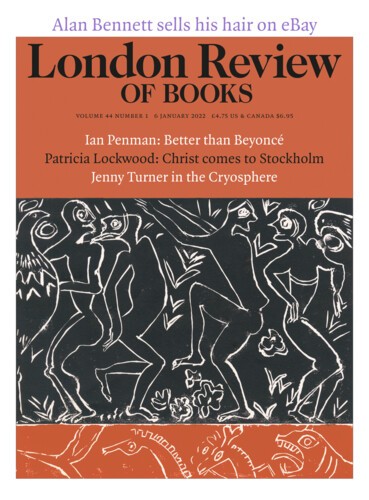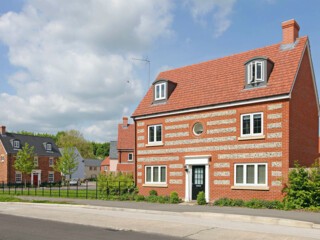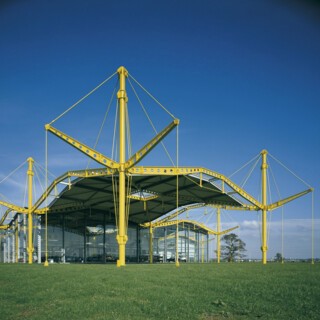In his introduction to the first edition of The Buildings of England: Wiltshire (1963), Nikolaus Pevsner wrote with barely contained anger that
Wiltshire would be as wonderful as it must have been in Hardy’s, in Hudson’s and in Jefferies’s days, if the army, and more recently the air force, had not got hold of it. As it is, the army is up in Salisbury Plain with towns of barracks and genteel soldiers’ housing and with all the mess of tin huts and tank tracks, and the air force is down in the northern plain with the mess of the airfields and the noise of the planes.
Things haven’t improved. The insipid neo-Georgianism of the barracks, housing, churches and messes of the 1920s and 1930s, designed by the War Office architect W.A. Ross, was evidently a source of inspiration to successive generations of military architects who have competed to outdo one another in dullness. Every fashion in low-rise social housing – garden suburb, bogus ‘vernacular’, system-built instant failure, pseudo-Victorian terraces, Poundburyish set design (the ‘Canadian Estate’ at Bulford) – has been meekly essayed in the sure knowledge that the hutches will never be anything more than temporary accommodation: the Professionals move on after two years. The camps aren’t trashy. If only. Rather they occasion inoffence on a dispiriting scale. They blight the plain, which is further defaced by vandals in uniform who treat it as a playground and scrapyard: danger areas and their alarmist signs; unexploded ordnance; live firing (260,000 rounds per annum); burned-out tanks, like an installation by a pyromaniacal Anselm Kiefer; rusting planes; racetracks for armoured personnel carriers; overgrown unidentifiable kit; the ghost village of Imber, requisitioned, like Tyneham, in 1943 and now largely destroyed in gung-ho exercises.
Two birds with one stone: the A303 should be diverted north just west of Parkhouse crossroads (the site of the Battle of the Beanfield in 1985, when police from Wiltshire and five adjacent sties plus troops in porcine disguise ambushed and assaulted New Age travellers en route to Stonehenge: there is no monument). The Imber Model should be followed and the mostly worthless buildings of Bulford, Durrington and Larkhill demolished to accommodate a northern loop in the A303, which will avoid Stonehenge then turn south to rejoin the current route west of Winterbourne Stoke. Stonehenge’s environs would be protected, the eyesores of the camps eradicated and the grasslands saved. The plain is Britain’s only steppe. Like the steppe of the Volgograd oblast and the steppe of Lorraine and, most pertinently, Stonehenge itself, it belongs to the sublime.
Its treatment over the century and a bit since the khaki oafs arrived has been disgraceful but perhaps unsurprising. Julian Orbach disagrees. Unlike his predecessor, he is sanguine about martial ubiquity. But then he lives in a part of the county untouched by squaddies, pongos and pads, and so has never known the boom of night-time field guns and matutinal coats of soot. More typically the armed services treat great swathes of Wiltshire as if they are invading or colonising forces. The lives of their personnel are hermetic, often by choice; they enjoy voluntary apartheid. They come, they trash, they go away again.
The A303 is a boundary as well as an intractable problem. To its north is three-quarters of a place called Wiltshire, which is alien to most inhabitants of the south. Bradford-on-Avon might belong to the Calder Valley; Hilperton Road in Trowbridge is all pompier merchants’ houses like Bruntsfield or Morningside. South of the A303 is a very different land of douce rivers, intimate valleys, floated meadows, precipitous combes, hidden villages, Beckford and more Beckford, England’s highest spire and finest cathedral close, mathematical tiles (bogus bricks) and an abandoned canal that was to have linked Salisbury to Southampton, the Avon to the Test, Wilts to Hants. It’s a measure of Orbach’s curiosity, research and fieldwork that he has found the ruins of this little-known venture, even if he has overlooked the remaining reservoir five miles south-east of Salisbury at a thickly wooded place of knee-deep leafmeal and perpetual dusk called Pope’s Bottom. It is now a coarse fishery which abuts the estate of Clarendon Park. The omission of this great house from the first edition was surprising, and perhaps evidence of Pevsner’s reluctance to explore for himself rather than follow his research assistants’ prepared programmes. Dendrochronology and an inscription suggest it is of 1716-19, dates which ‘group it with works of Vanbrugh and Hawksmoor’. Invoking those artists rather flatters whoever designed it (Orbach proposes John James). The third prodigy of the English baroque, Thomas Archer, like Vanbrugh worked nearby in Dorset and Hampshire (both of which south Wiltshire might comfortably be part of). Vanbrugh is the possible author of Netherhampton House, between Salisbury and Wilton, a Venturi ‘shed’ avant la lettre. A spectacularly theatrical screen – it gives façadism a good name – hides a more ordinary building of a generation earlier.
The tendency to maul or demolish work of the recent past is nothing new. Buildings have always been both accretive and expendable. A mill at the confluence of the Nadder and the Wylye at Quidhampton was the first of three to be destroyed in the mid 1960s. The other two, in Salisbury, close by each other at Fisherton, where the stately mill house remains, were not, pace Orbach, demolished ‘to connect Mill Street to the centre’. There is no such street. They were levelled to give a property developer access to an island where he would build a dozen dreary houses. The mill at Quidhampton fell to a road-widening scheme. The road is often now referred to as ‘the ring road’. It is no such thing. Salisbury is very likely the only British city of its size (population pushing fifty thousand) which has no bypass. Thus traffic between Southampton and Bristol thunders down suburban roads when it is not at a standstill belching particulates into the atmosphere.
The lack of a bypass is evidence of the parochial mismanagement, casual corruption and sharp practice that sully the city. The ‘ring road’ was devised by Harry Rackham, a hapless city engineer. His Salisbury Crematorium is a felicitous lift from Scandinavia via the Festival of Britain. But as a road planner he was out of his depth. His ‘legacy’, sixty years on, is one of visible destruction. Tarmac-happy, he dumped his road on the hitherto intact medieval grid (or chequer) of streets, eliminating, inter alia, many early 19th-century cottages, Victorian terraces and a grand 15th-century house that was home to the Swan School. For years a ‘road to nowhere’ (in fact to an unbuilt car park) stood on piloti above the surviving houses. A succession of streets ends incoherently in blind walls and service roads. Completeness is sacrificed to the demands of traffic, a bogus god even in those days. In a tunnel beneath the wretched road, that which has been lost is commemorated by murals. But the amputations are irreversible.
Rackham’s hands were tied, of course. Any bypass would have had to contend with Wiltshire’s multitude of rivers, watercourses, canalisations, leats and feeders. But these problems, which might have been elegantly resolved by an architect-engineer, were as nothing next to the power of the great estates that the rivers flow through – Wilton House and Longford Castle. Sixty years ago deference was assumed. The earls of Radnor and Pembroke did not get where they are by ceding their land for the common good. This holds true today, as too do the last rites of deference: London is ninety miles and many decades distant. The hierarchies of the military and the landed nobility are matched by those of the Church, whose temporal power is unusually broad because it is a major landlord. Anglicanism is not necessarily good for the health of buildings in the stewardship of its clergy. The Church is often the enemy of churches. The Salisbury diocese has a history of wrong-headed deans. These gentlemen may have been top god-botherers but that was no reason to let them loose on one of the finest buildings in the world (exterior only). Thirty years ago, Hugh Dickinson proposed knocking down a Grade 1 listed wall to admit tourist coaches and so increase revenue (and the likelihood of floods). He didn’t get away with it. Sixty years ago, Kenneth Haworth removed George Gilbert Scott’s reredos and transparent iron screen from the chancel. He did get away with it. Pevsner wrote that it was ‘a crime against the tenets of the Victorian Society but the need of the 13th-century cathedral was indeed greater than theirs’. Orbach doesn’t comment. He does however quietly point out that Scott was commissioned to undertake the restoration of the cathedral because Henry Clutton, who had originally been appointed and had done the Chapter House (assisted by William Burges, experimenting with colours), rendered himself ineligible by converting to Catholicism.
Had Clutton continued, the cathedral would be a building rather different from the one we see today. He wasn’t a man to hide his Francophile eccentricities. Minley Manor, for instance, has a wildness that Scott never matched, and would probably not have wished to match. Clutton’s flamboyance would have mitigated the sullen ungainliness of the exterior and the sheer joylessness of the interior. Orbach, not given to hyperbole, prefers ‘a certain coolness’. Either way, it reeks of desiccated theolatry and the banality of superstition. The only relief is in the monuments. The star turn is the monument to Sir Thomas Gorges, the builder of Longford Castle, and his wife, the dowager marchioness of Northampton. It is a farouche gallimaufry of symbols, obelisks, inscriptions, painfully twisted columns, heraldic devices and extravagant pediments. The harshness is also relieved by the chantry chapel – chantries were as preposterous a racket as relics but evidently didn’t involve fakery. Bishop Audley’s is early 16th century, a happy intruder, far from ‘in keeping’. Bishop Wordsworth, great-nephew of the poet, is commemorated by George Frampton in white marble, supine, fingers intertwined as though sleeping off a heavy lunch. He is almost as dead as the supposedly living figures painted by Frampton’s son, Meredith, now in the Tate’s collection. They are minutely detailed simulacra of humans that look like waxworks. This singular artist designed a house for himself, Hill Barn, on the downs near Mere. Orbach’s description of Hill Barn as ‘slightly French’ is unexceptionable. There is indeed an oeil de boeuf window. It belongs to no school, though there is some affinity with another self-designed, but suburban, house of a very different painter, Roger Fry. The inclusion of this remote, largely unrecorded site is again testimony to Orbach’s determination and willingness to follow rutted, unmade, probably private roads through parched fields. (Betjeman said that a lodge, a drive and a ‘Keep Out’ sign was an invitation to trespass.)
Hall Barn is of course atypical of Wiltshire’s 20th-century buildings. It is one of a small and variegated group that are exceptions to the dismal norm. Two of the best have been demolished: the Reliance Controls factory at Swindon by the structural engineer Anthony Hunt and the young Norman Foster and Richard Rogers, who were then part of Team 4; and the first hyperbolic paraboloid roof in Britain, created in 1957 by Robert Townsend for the Wilton Royal carpet factory. Townsend’s own house in the otherwise benighted village of Durrington is extant and retains its freshness. Orbach considers it ‘the most interesting house of its period in the county’. The period, however, was 1951-52, when building licences were in force and few got off the ground. Not much competition, then.
The survivors also include Guy Dawber’s late Arts and Crafts Hamptworth Lodge; the ‘cathedral among Swindon’s giant sheds’, Arup and Foster’s mannered ‘high-tech’ Renault Centre; and, nearby, in the middle of an estate of executive period homes with three-SUV garages, a vast green pantiled Chinese fantasy which houses the Hongxin Oriental Buffet – all you can eat for £12. It’s a more raucous performance than I.M. Pei’s arty pavilion for the Keswick family at Oare, south of Marlborough. There are commendable extensions to the New Art Centre at Roche Court, to a nearby house by Michael Manser and to the Council House in Salisbury. Douglas Stephen’s David Murray John Tower in central Swindon is one of the finest buildings in Britain of its age (early 1970s) – a sleek homage to Frank Hampson, illustrator of Dan Dare. And that’s about it. Little remains unchanged of the Department of Scientific and Industrial Building Research Board’s farm colony at Amesbury, where soldiers returning from the First World War were housed in flat-roofed, proto-modernist buildings of different materials (brick, concrete, compressed earth, clunch, cob) to determine which might be more widely employed. The answer was none of them. The plotland village of Palestine, a few miles east in Hampshire, has proved more enduring.
Wiltshire, in the grip of the Church, the army and the past, gets the architecture and sub-architecture that reflects those unhappy fates. The current Fonthill is a neo-Georgian barrack of the early 1970s that insults the name. The most recent large country house is inevitably classical and equally inevitably by Quinlan and Francis Terry. Although commissioned by a Rothermere, it includes no allusions to Albert Speer. It does however ‘quote’ from William Kent and Bernini in an excess of self-validation, a show of ‘good taste’ that is about as convincing as the plastic pilasters attached to a footballer’s ‘mansion’ in Alderley Edge. Orbach’s is a fine work of burrowing and scholarship. He writes with energy. His text is often elliptical, composed of hardly polished notes – a sort of shorthand that lends the book an enjoyable immediacy. It is often more interesting, more rewarding, than what it describes. It doesn’t make me yearn to revisit my home of long ago.
Send Letters To:
The Editor
London Review of Books,
28 Little Russell Street
London, WC1A 2HN
letters@lrb.co.uk
Please include name, address, and a telephone number.



